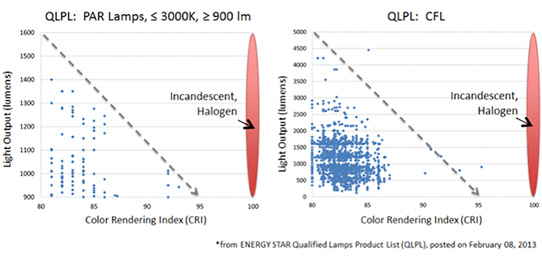- News
24 May 2013
Soraa requests EPA’s ENERGY STAR program to address LED lighting color quality
To ensure the long-term success and widespread market adoption of LED lamps, Soraa Inc of Fremont, CA, USA, which develops solid-state lighting technology built on ‘GaN on GaN’ (gallium nitride on gallium nitride) substrates, has urged the US Environmental Protection Agency’s (EPA) ENERGY STAR program to address light quality - specifically color rendering - in its new lamp specification. Support for higher color rendering has been expressed by many individuals and industry groups, including the California Lighting Technology Center; professors Shuji Nakamura and Steven DenBaars at the University of California Santa Barbara; the International Association of Lighting Designers (IALD); Northeast Utilities Companies (NSTAR); and lighting designer Chip Israel; who all filed formal comments on EPA’s Draft 3 product specification for LED lamps.
“Poor light quality ruined many consumers’ confidence in compact fluorescents,” says Soraa’s chief technology officer Mike Krames. “The ENERGY STAR qualification must be associated with LED lamps that provide a better quality of light; otherwise, the program will start to lack credibility with end-users and the low adoption rate history of CFLs will be repeated by LED lamps,” he adds.
In comments filed with the EPA on 17 May, Soraa told EPA that, while ENERGY STAR is not a mandatory standard, the Agency must recognize that it has become a de-facto standard for utility rebate dollars critical to lowering the initial cost of LED products. In the absence of a second high-color-rendering-index (CRI) tier, it is likely that, similar to the historical situation with compact fluorescent lamps (CFLs), the vast majority of lamp products will engineered to perform close to the lower boundaries of quality requirements as set in the ENERGY STAR lamp specification for cost reasons. Left unaddressed, this lack of high color quality lighting products will lead to a stalling in consumer adoption of energy efficient lighting technology, similar to what has been observed to date with CFLs, says Soraa.

Above: light output versus CRI for both PAR lamps (left) and CFL (right) from the ENERGY STAR Qualified Lighting Product List (QLPL), compared to conventional light sources (red ovals). Existing standards drive the industry to produce modest color quality lamps, which do not address the color quality barrier to adoption.
“To persuade consumers to purchase LEDs instead of incandescent lamps, LED lamps must be seen as high-quality products worth the initial higher price differential,” says Ravi Parikh, Energy Services Specialist at Burlington Electric in Vermont. “Therefore, LED lamps must closely replicate the color rendering of the incandescent and halogen lamps that they replace,” he adds. “The Soraa VIVID is such a product, providing superior color quality while improving energy efficiency,” Parikh claims. “As a utility, we are always willing to consider higher incentives for projects utilizing lamps such as Soraa’s. We want to ensure customer satisfaction by reduced energy bills and maintained — if not, improved — quality of light. There is no need to sacrifice quality for efficiency. It is critical we understand the value in both.”
To provide a more balanced portfolio of ENERGY STAR lamp products on the market and mitigate color quality as a barrier to wider adoption of energy efficient lighting products, Soraa proposed to the EPA a second high-CRI tier with differential efficacy requirements, taking into account the inherent lumen per watt trade-off as a function of CRI for phosphor converted white LEDs. Soraa proposed to keep the existing minimum efficacy requirements, but to raise the color quality to a minimum CRI of 90. For lamps with CRI of 80-90, Soraa proposes to increase the luminous efficacy requirements.
Soraa says that adoption of its proposal would increase overall energy savings through enhanced adoption of higher-light-quality lamps as well as through higher energy efficiency in lamps of modest light quality.
www.soraa.com/public/docs/Soraa-Comments-to-E-Star-draft-4



